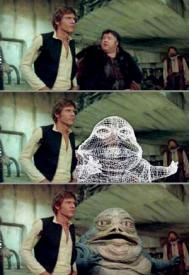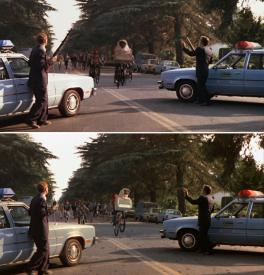Article
Movies, A Living Art
Written by Eric, Scott
First Posted: October 15th, 2014

Harrison Ford and Jabba the Hut in Star Wars
Have you ever thought of a movie as a work of art or heard of one described as a “masterpiece”? Films are indeed artistic creations. Unlike classical art, such as The Mona Lisa or Venus de Milo, movies may be considered living pieces of art. That is to say, some movies get changed over time. For example, it was briefly a fad to colorize old black and white films, but are The Three Stooges any funnier in color?
At one time, movies were made, shown and put in the can. Then television came along and movies suddenly lost their integrity. To show theatrical movies on television, films had scenes shortened or cut to fit into a scheduled time slot and allow for commercial breaks. Curse words had to be changed or edited out. Gore and nudity erased altogether. Some films had to have pan and scan editing. There is a scene in Lawrence of Arabia (1962) in which Peter O’Toole and Omar Sharif talk to each other from opposite sides of the wide movie screen. When shown on television, neither is even in the shot. It had to be manipulated with the camera panning over to one actor and then the other. The artistic vision of the film makers was no longer entirely intact.
Some films were creatively changed when shown on television. The Godfather Part II (1974) contains scenes of a young Vito Corleone who died in the first film. When The Godfather films were shown on television together they were re-edited to show the scenes of young Vito Corleone first, before the events in the first film were shown.
Foreign films sometimes have different versions for a U.S. release. The European version of Leon (1994) ran longer than the movie shown in North American theaters. The European version contained some scenes deemed unsuitable for all audiences, this includes a scene where an under aged Natalie Portman asked a middle aged Jean Reno to take her virginity.
Some movies have been re-edited for video/DVD releases, with additional scenes for an extended cut. The Big Red One (1980) ran 116 minutes when released in theaters. In 2004 a 160 minute version was put together from extra footage originally shot. A longer version of Das Boot (1981) took the original 145 minute run time and extended it to a whopping 210 minutes.
When the three Star Wars prequels were in preproduction, George Lucas went back to his original trilogy and added scenes and special effects to re-release them to theaters before the new prequels. This included putting one scene, originally shot for Star Wars (1977). It features Jabba the Hut, played by an actor, confronting Han Solo, played by Harrison Ford. Lucas had the actor covered by a CGI Jabba, to match the later depictions of the alien mob boss.
Ridley Scott’s Blade Runner (1982) is possibly one of the most altered films in Hollywood history. There have been a half of a dozen different versions of Blade Runner put together at one time or another. Some have and some do not have the narration. There are different endings and scenes depending on whichever version you watch. Many fans believe the Ridley Scott approved Final Cut, released in 2007 is the better of them all.
Superman II (1981) was originally directed by Richard Donner. He filmed nearly all of the primary scenes before disputing with the father-son producing team of Alexander and Ilya Salkind. Their disagreements escalated until Donner was fired from the project before completion. The Salkinds then recruited Richard Lester to finish it. Lester didn't just finish the film however; he reshot many scenes so that his contributions would equal at least 51% of finished footage to enable him to receive sole director's credit. The final edit of the film has been estimated to be around 75% Lester/25% Donner. After an online fan movement to see the original scenes, an elaborate search and process took place that put Richard Donner’s vision or Superman II back together. Marlon Brando's part was restored and Donner even used an audition scene between Christopher Reeves and Margot Kidder. The Donner Cut, as it is called, is a more serious film than the Lester movie and is a far superior watch.
Some changes to original films have made improvements, while others just made us scratch our heads. E.T. has been hailed as Steven Spielberg’s most successful film and may always be the movie he is most remembered for. With such a legacy locked in, I wondered why he would bother to go back and erase all of the guns and replace them with walkie talkies. He wondered as well and explained at a 30th anniversary showing of E.T., "For myself, I tried [changing a film] once and lived to regret it. Not because of fan outrage, but because I was disappointed in myself. I got overly sensitive to some of the reaction to E.T., and I thought if technology evolved, I might go in and change some things. It was OK for a while, but I realized what I had done was I had robbed people who loved E.T. of their memories of E.T. If I put just one cut of E.T. on Blu-ray and it was the 1982, would anyone object to that?” The crowd reportedly yelled "NO!" in unison. To which Spielberg added, “OK, so be it."
Peter Jackson took on the daunting task of directing The Lord of The Rings trilogy. The books are long and full of details. He had to make serious cuts to all of them to keep the movies at a watchable length for cinematic showings. The movies were never-the-less a resounding success. When they made their appearance on DVD, Jackson was able to put back many scenes. The extended versions included some entirely new storylines and enhancements of others. They are even longer movies but well worth the watch as they incorporate more of the world of JRR Tolkien’s Middle Earth.

E.T. The 1982 version with guns and the 2002 version with walkie talkies.
I recall a conversation many years ago when a mentor of mine said it would be sacrilege to colorize Casablanca (1942). He explained that the final scene at the foggy airport has all the atmosphere it needs without the use of color. I agree completely. In fact, the idea that art can be changed implies it is not true art. Would putting the arms back on the Venus de Milo make it better? Would changing the tornado scenes in the 1939 version of The Wizard of Oz with a CGI storm make the movie more entertaining?
The enjoyment of art; be it a painting, sculpture, song or movie is based on a personal emotional reaction within the viewer/listener. Art has always been open to interpretation and thus you may think treating movies like living art is the right way to go or you may be a purist and not want a movie you adore altered in any way. But alas, movies are not just art but also money makers and with that there will always be the debate between the artistic look of a film and its shot at making a handsome profit. As Hollywood is a business first and foremost, the money suppliers will always get their way, at least until it is decided that an extended version may make money as well.
